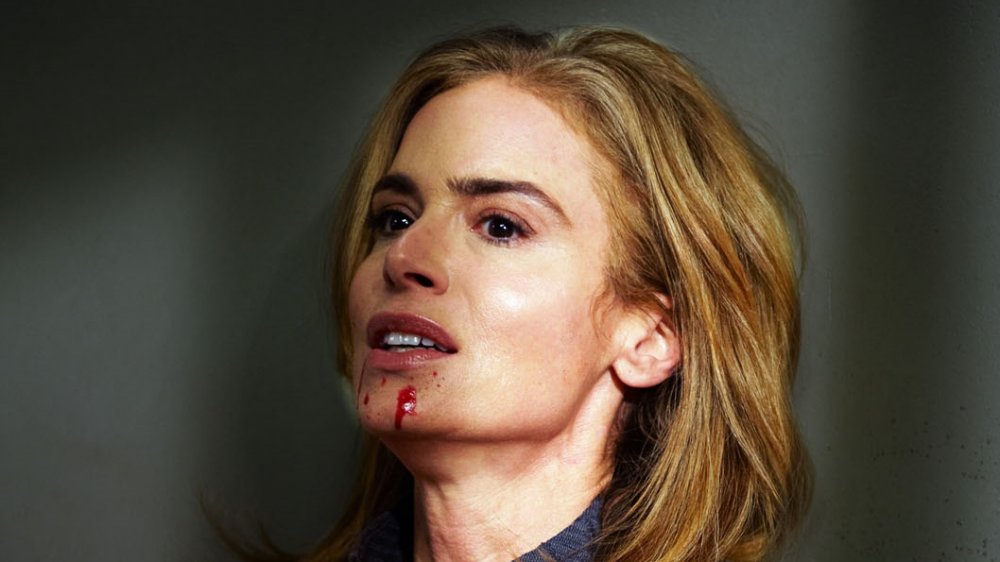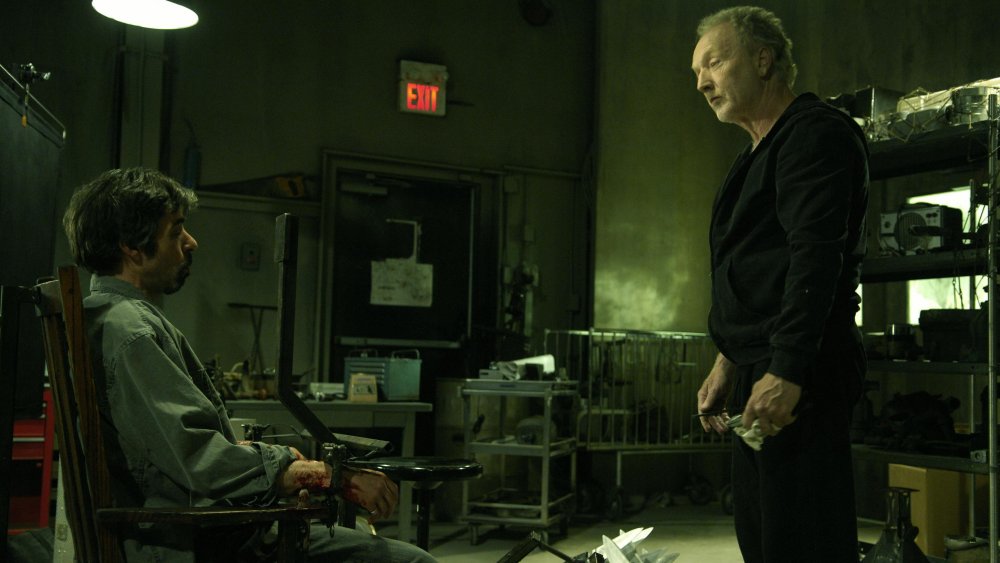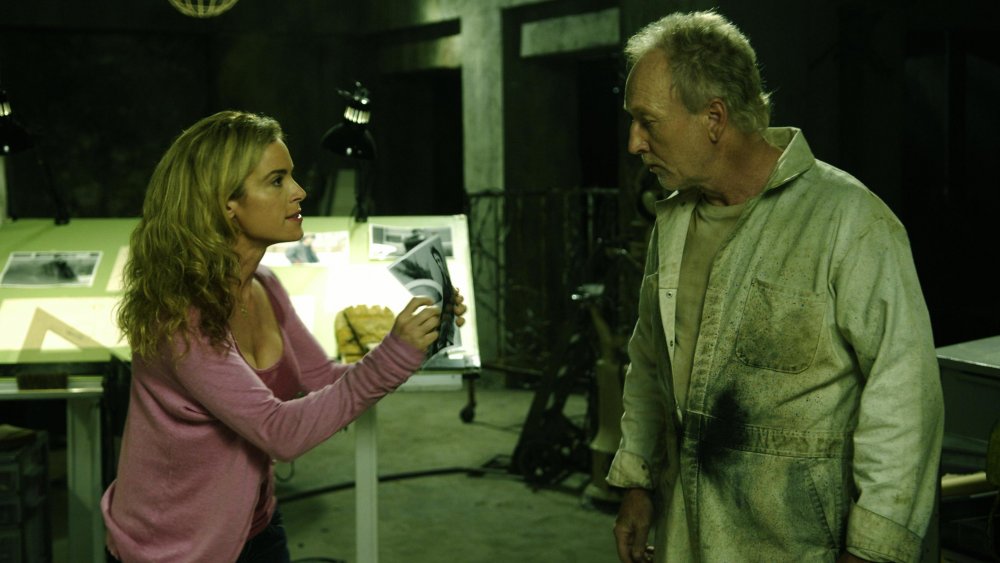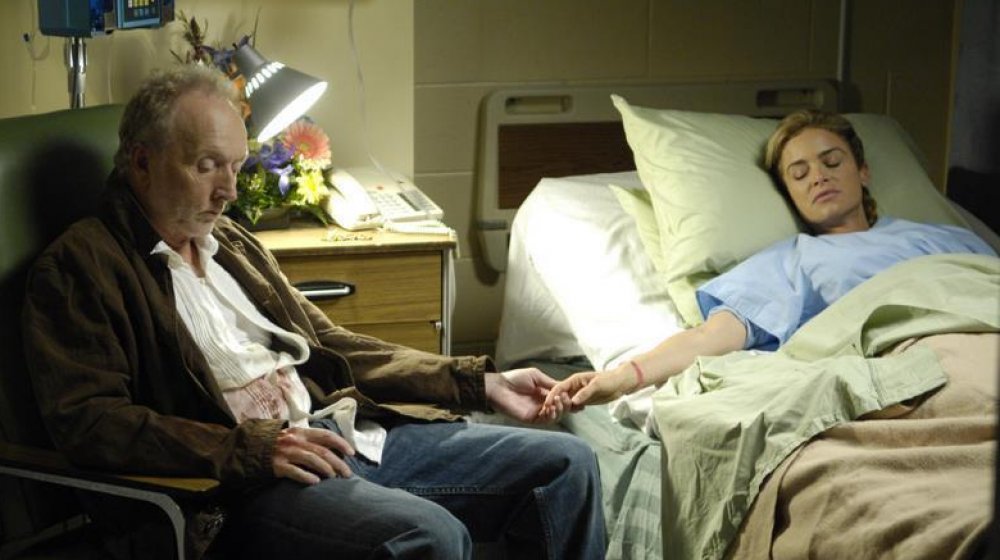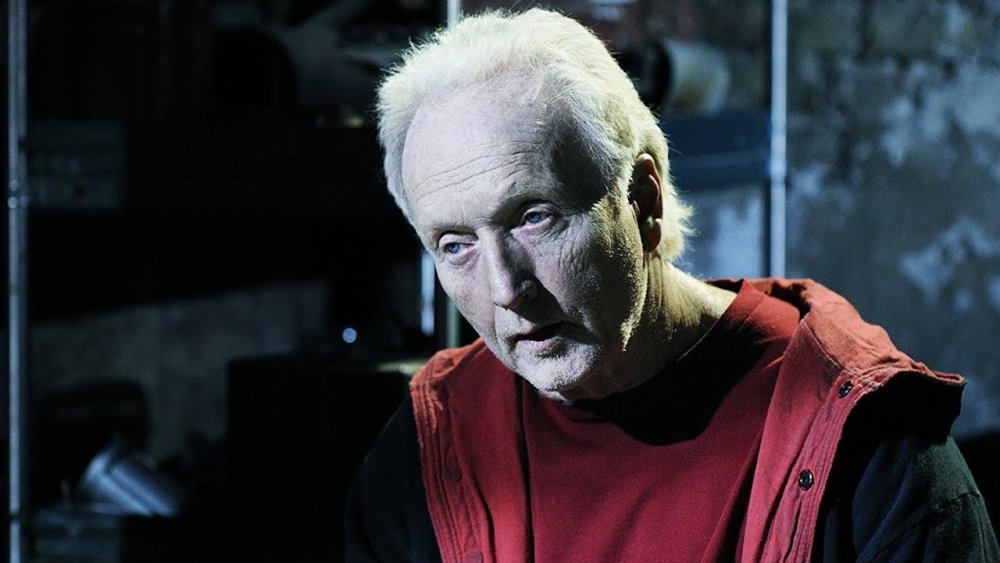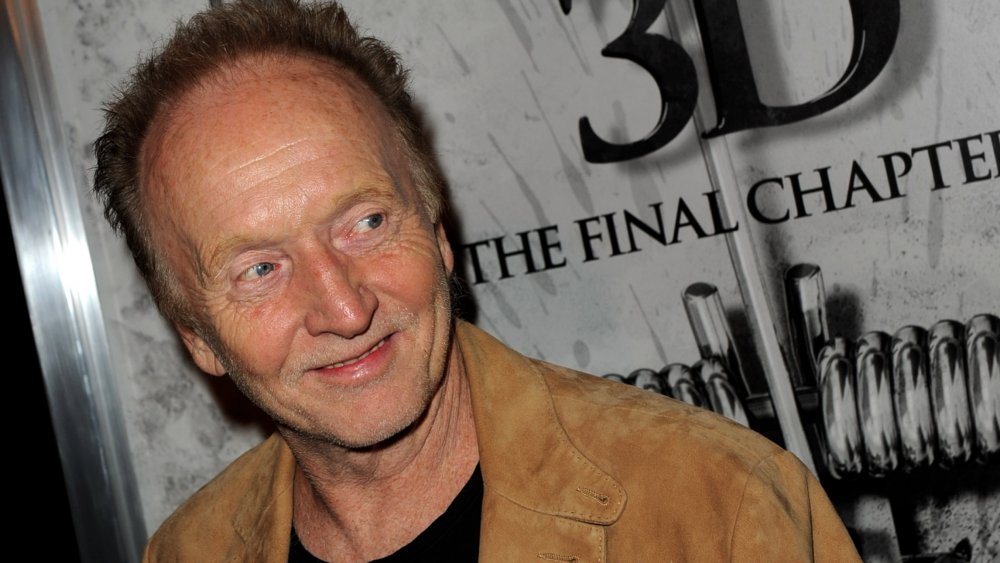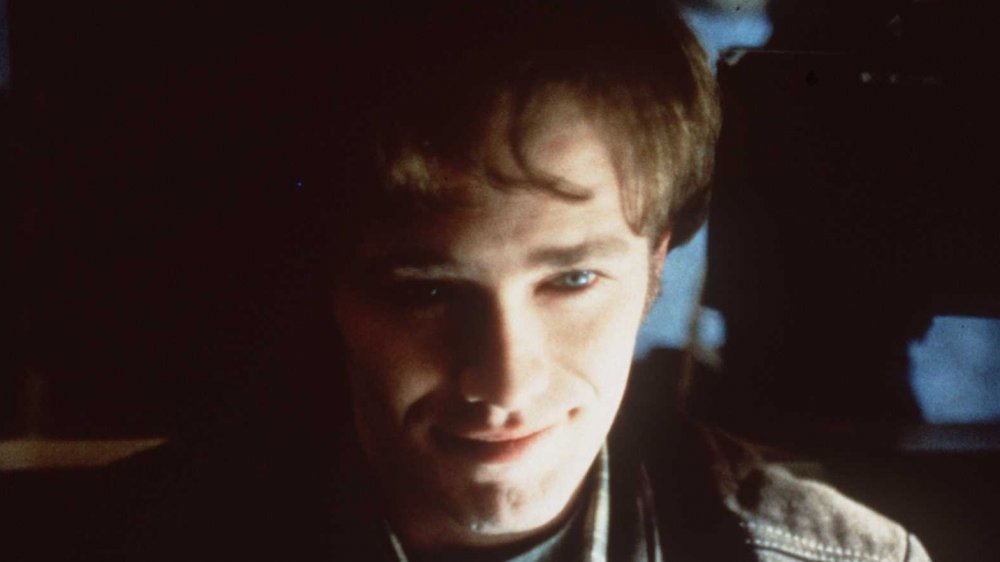Jigsaw's Entire Backstory Explained
The first Saw movie was perfectly timed to ride a wave of resurgent splatter horror. The fact that it wasn't a one-hit-wonder is a credit to the team behind it, who have kept the series thriving. Their secret weapon? Jigsaw, villain of the Saw series, horror's most surprisingly sympathetic puppet.
Genre films depend upon their villains. It's why Batman Forever is maligned for trotting out Jim Carrey's Riddler, while The Dark Knight is beloved for Heath Ledger's Joker. Horror films are particularly determined by the strength of their villain, especially when they branch out into sequels — the bad guy tends to be the connective tissue between films. Sure, we root for the do-gooders, but what we really enjoy is seeing them face off against a depraved bad guy. When it comes to horror, it's all about the monsters.
And Jigsaw is one heck of a monster. While Saw's gory contemporaries are fine with hand-waving away the villain as a hillbilly or a kooky European, Saw fleshes out a man with a warped but believable motive over the course of nine films. The result is a deeply disturbed genius who puts his smarts to ever more gruesome ends. This is his story.
A charitable beginning
There's no doubt that Jigsaw's life took a deeply dark turn. Yet before he became Jigsaw, John Kramer led a genuinely upright life.
John Kramer, a civil engineer, was utterly dedicated to making cities better places to live. With his business partner, a lawyer named Art Blank, he started a foundation with the goal of creating affordable housing for working families. The Urban Renewal Group launched with the motto "four walls build a home," and set about revitalizing old, distressed properties to make them livable for needy people.
In spite of this focus on home-building, the foundation's first major project was a meatpacking plant. This was presumably undertaken to provide jobs for blue-collar workers in New York City. But this plant had a far darker destiny — it would become a base of operations for John after he became a serial murderer, with Jigsaw taking full advantage of the plant's capacity for grotesque horror.
Jigsaw's wife
We often imagine serial killers as extreme loners, driven mad by their own ostracization from society. John Kramer is very much the opposite. He was a man of and for the people, and he lived a relatively straight-forward, white picket fence sort of life. Prior to becoming Jigsaw, he married Jill Tuck. His charitable nature rubbed off on his wife, who Kramer convinced to open the Homeward Bound Clinic, aimed at helping drug addicts recover and build new lives.
Jill worked at the clinic all through her pregnancy with their first child, who Kramer hoped to name Gideon. Alongside her team of nurses, Jill dealt with people hoping to kick their opiate addictions with kindness, strength, and perseverance. Though he encouraged her to start the clinic, Kramer's increasing sense of the danger of Jill's job began to weigh on him, particularly as her pregnancy progressed. Tension mounted with no escape valve to be found.
A chance meeting
Much of Kramer's pre-Jigsaw life would extend, albeit in a twisted fashion, into his career as a serial killer. The knowledge he'd gained as an engineer and builder would come to grotesque fruition in his murderous contraptions. Jill's clinic, with its motto of "cherish your life," would inspire Jigsaw's goal for his victims. His life as Jigsaw is an entirely different beast than his life as Kramer — but they are in no way unconnected.
In time, John Kramer met a man named William Easton at a party thrown at the clinic. Easton was the head of Umbrella Insurance, and he revealed an algorithm his company used to distribute care, essentially placing a concrete value on each individual human life. Kramer was horrified both by the concept and by the variables Easton used. He thought that the equation was faulty because it didn't take into account a patient's will to live. This was a brutal lesson in the mathematics of morality — one that would leave Kramer forever changed.
Brush with danger
Kramer became more and more uneasy about Jill's workplace. An incident between two patients only fueled his fear: One night at the clinic, as he waited to pick up his wife, Kramer got between two patients about to come to blows. One of the men, named Cecil Adams, pulled a knife on John. Kramer was able to successfully talk Adams down, convincing him to drop the knife and even managing to deliver a lecture on how one's mistakes can spiral out of control and affect society at large.
Adams' problems, Kramer told him, were not likely to stay his problems for long, but to blossom outward and become the problems of other, innocent people. He worried that the costs of Cecil's habits would be paid by a bystander or borne by friends and family if he continued to bounce in and out of treatment. Though he had no way to know it at the time, John Kramer was speechifying about his own future.
Losing their child
Despite Kramer's warning, Cecil Adams returned to the clinic. The sick and reeling Adams threatened Jill with a knife and forced her to open the door. He backed the visibly pregnant Jill up against a wall and commanded her to stay put while he ran to the back to steal supplies of methadone.
As Cecil ran out of the back room with the stolen medication, he accidentally hit Jill in the stomach with the doorknob. Jill began to bleed and collapsed to the floor. Hurting Jill gave Cecil pause, and he knelt down to tend to her. However, once he realized that he may have hurt Jill's unborn child, he ran from the clinic.
Kramer was waiting out front of the clinic, again ready to pick up his wife. When he saw Cecil leaving in a panic, he ran in to see if anyone was hurt. John found his wife bleeding on the floor and took her to a nearby hospital. Jill and John's first child, Gideon, had been lost. They were utterly devastated, and would never attempt to have another child.
Severe depression
Gideon's death took John to a dark place. He began refusing to see his wife or go to work. He abandoned his mission to build housing for the needy. His withdrawal from the world was so complete that neither Jill nor his business partner Art Blank knew where to find him. They finally found John in his workshop, where he had built a frightening and familiar doll for his unborn son. Even within the workshop, surrounded by the instruments of his art, his presence was so diminished that both Blank and Tuck failed to see him at first.
Blank attempted to use the idea of meaningful work to pull Kramer out of his funk. He argued that he'd be abandoning the people who needed his help the most. Blank urged Kramer not to walk away from the needy families they had helped, who were ready to move in. He was, as Blank argued, their savior, and they needed him now more than ever.
Kramer was unmoved. Jill delivered a parting blow, telling John that she suffered as much if not more from Gideon's death. She separated from John after he proved unable to right himself.
Shocking diagnosis
After splitting from Jill, John began to deteriorate. When it became clear that his physical ailments were more than just side effects of his deep depression, Kramer went to the hospital to have some tests run. It quickly became clear that Kramer was suffering from colon cancer and had an additional tumor in the frontal lobe of his brain. He started chemotherapy immediately.
Kramer was starting with a deficit, however: He was late in beginning his treatment as one of the hospital's residents accidentally mixed his imaging results with another patient. By the time the tumor in Kramer's brain was discovered, the doctors believed it to be inoperable. The chemotherapy he underwent was particularly intense — and his condition only worsened. Kramer desperately began to seek out experimental cancer treatment in the hopes of surviving this sudden, internal attack. The clock was ticking, and the odds were against him.
Easton, revisited
The need for funds and approval to undergo a radical treatment in Norway drove Kramer to a meeting with William Easton, the insurance company executive who had so shaken Kramer with his brutal monetization of human life. Easton couldn't cover Kramer's cost, based on the aforementioned algorithms Umbrella Insurance applied to all cases. As he'd explained in their earlier meeting, his company determined whether or not a patient's health was a good investment and went from there.
"In essence, it breaks down to monthly payments multiplied by lifespan, minus the probability of illness, and if its sum is positive, we consider coverage," he'd explained. And Kramer was not a good investment.
In this meeting, the stark cruelty of this calculus became fully apparent to Kramer. Easton explained that his company couldn't cover the experimental treatments and would cancel his coverage for regular chemotherapy if he attempted to seek out the treatments on his own. Kramer was utterly adrift.
A new beginning
Fully convinced that he was going to die and separated from everyone he had once loved, John Kramer made the decision to end his own life. He drove off a cliff — and to his shock, lived to tell the tale.
He emerged from the crash feeling invigorated, despite his grievous injuries. He realized that a true brush with death had made him realize how precious life is. Kramer began to think that other people could do with a near-death experience of their own. If he could make people he viewed as degenerate or morally lacking come face-to-face with their own deaths, could he reform them? Would they come to the same conclusions he had, and make necessary changes in their lives?
Invigorated, he dedicated himself to this cause, devising perverse and brutal games and tests that he believed would push people to their limits and discover their will to live. Though he continued to waste away, his cancer unabated, Kramer created the Jigsaw personality and set to work on his infamous contraptions. A monster had been born.


